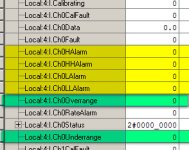Hello folks,
If I am using the 1756-IF16 Analog Input card to sense a 0 - 20mA input signal, in RSLogix 500, under the Module Properties -> High Signal Scaling, why can't I change the High Signal from 20.0 mA to say, 20.5 mA?
When I try to do so, I get an error stating that the
"Signal Settings Must Be Within Range"
The reason is that I am getting Out of Range Alarms when the field device is outputting say, 20.2 mA into the Analog Card, so I want to respan the card's input mA signal and Engineering Ranges.
Thoughts?
Thanks in advance
If I am using the 1756-IF16 Analog Input card to sense a 0 - 20mA input signal, in RSLogix 500, under the Module Properties -> High Signal Scaling, why can't I change the High Signal from 20.0 mA to say, 20.5 mA?
When I try to do so, I get an error stating that the
"Signal Settings Must Be Within Range"
The reason is that I am getting Out of Range Alarms when the field device is outputting say, 20.2 mA into the Analog Card, so I want to respan the card's input mA signal and Engineering Ranges.
Thoughts?
Thanks in advance






